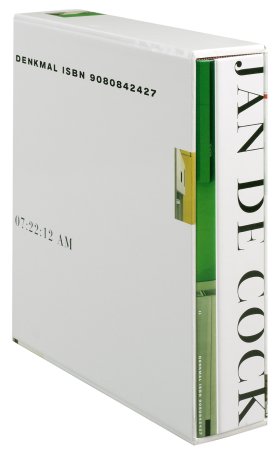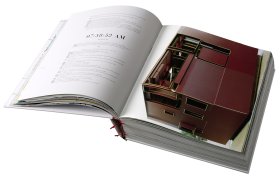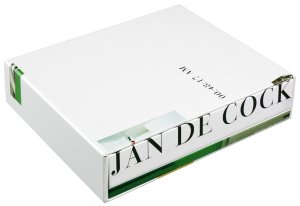Volume 31, No. 3, Dec 2008
Interview with Jan de Cock about his bookwork, Denkmal ISBN 908042427, 2006
— by Judith A. Hoffberg, editor of Umbrella Online
Since you began your art practice as a sculptor, how did you find yourself getting interested in artist books?
JDC: Actually I have always been interested in artist books, even before I was an artist myself. Now books in general have taken a central place in my work. Even in my studio environment, books surround me. They are inspirational to me and sometimes I incorporate them literally in my artwork, as I did in certain modules. In this case the cover of the books are photographed and are as important as any other image or photo. Not only the content of a book can be an inspiration, but also the layout.
Your first Denkmal was created in the U.S. at the New York Art Book Fair last November. Describe for Umbrella Online readers what you used to create it and what triggered this work. Was it a kind of portability for all that you do?

JDC: First of all I have to correct you: I created my first Denkmal years ago. Every exhibition or installation I make gets the general title ’Denkmal’, followed by the civic number of the location of the installation or exhibition. Because of the fact that my books are as important to me as any other exhibition or installation, the two books also got the name Denkmal. In case of the books, ’Denkmal’ is followed by the isbn number. More specifically, the title of my second book that was presented in New York is: Denkmal ISBN 908042427, 2006.
The book is also an exhibition, but through another medium. I also present my work to the spectator, and as in an exhibition the spectator is guided through the works, but in the book this happens by a timeline and the page numbering and not literally in an actual space.
At the New York Art Book Fair I presented this second book to the American people. I want to mention the support, both financially and personally, I got from Ethan Wagner and Thea Westreich. They contributed a great part to this historical monument and were in fact also the co-publishers of the book. I consider them to be the moving force behind the book launch in New York.
Of course this artwork, this book is representative for all I do, in the meaning that a good artist has his own language. When you see only one work, you wouldn’t understand my language. It is really important to have seen several works to distinguish my language. As an artist it is important to have more than just an idea; you really have to invent your own language to be a good artist.
This now published new work, one of the heaviest books I have had in my lap besides an encyclopedia, reminds me of an assembling, a compendium of pages offered up by various artists all over the world, such as Richard Kostelanetz’s great compendiums during the wonderful days of Xerox. Now you are assembling your own works, but in a unique way. Tell me what generated your journey through book.

JDC: This book is an encyclopedia. Every book reflects the previous work and exhibitions, and overviews my work in general. Ultimately all the books I ever published will form a series of encyclopedia.The difference with an actual three-dimensional artwork is the fact that the books are a different kind of montage of my work. The book is an artwork on its own. It is as a museum space, in which I can make sketches, collages, designs and so on. I can make a totally new environment.
There is a definite timeline in the book, both verbal and visual. Would you allow me to call this volume a journal, a diary, a way of inserting your daily readings, art making, and exhibitions? Or should I be corrected and say that Denkmal isbn 9080842427 2006 is as much a work of art in your practice as your sculptures and installations?
JDC: Indeed my books are a work of art and are as important to me as any other sculpture or installation, as I said earlier. They can be read on multiple levels. You could say that it is an art book contrary to an artist book.
Therefore, my books are also considered to be a ’Denkmal’. This word has in fact two meanings: in the first place ’Denkmal’ is the German word for ’monument’. However in Dutch there are two words incorporated: ’denk’, which means ’think’ and ’mal’, which translates in ’mould’. And this is actually what sculpture is: creating a mould to think. What I make is a kind of monument. In fact a monument is an architectural artifact that doesn’t have a practical purpose. Although, concerning this matter I want to stress out that I am not an architect because I don’t have any rules. I can create whatever I want without taking matters as safety, or other practical rules into account.
The book is obviously not an architectural object; nonetheless, it is a monument. It is an encyclopedia, a monument, a two-dimensional installation.
The book is so idiosyncratic with multiple tables of contents, visual bibliographies, an essay by John Welchman, as well as pull-out pages that do not pull-out unless they are cut. I feel that you have created a new way of ’reading’ which I suppose is one of your intentions. But even the spine on the book is a double-spine with two ribbon bookmarks. You also seem to give us an insight into whom you read and how they affect your work. Am I correct that this is a new kind of “reading” both visually and verbally?

JDC: In the first place the book has to be seen as an artwork, an exhibition instead of a traditional book. The book has a Western part and a Japanese part. Actually, the book is set up very logically. The first part of the book is the Western part, and the volume after the piece of cardboard is the Japanese part, so this results in two tables of contents and two ribbons. Logically the Western part has to be read from left to right whereas the Japanese part in opposite direction. As you see all is very consistent, everything has a reason. As do the pages that were meant to fold out, but do not fold out. Here the reference to a sculpture or installation is very obvious. The perception of the ’visitor’ is guided: as in my sculptures there are holes you can peep in, but in general the sculptures have a closed character. There is something within, but what precisely is not quite clear. Another aspect of the book is indeed that I also show my sources. By doing this, people already know what I like. In a way the books show how I perceive life and reality. As I said earlier I have my own language and I admire other artists who also use a modern language such as the Constructivists, Malevitsj, Godard, Piero della Francesca and many others.
You seem to be testing van de Velde’s experiments as well—you never quite “chop off” the ends of words so that even the sense of “reading” has been converted by you to a new experience—where the printing of words is compromised but not completely. Our intuition completes the ends of sentences and the continuing of paragraphs from page to page, almost as if John Welchman’s descriptions of entering your Denkmal 7, Schirn Kunsthalle Frankfurt, Rmerberg 7, Frankfurt am Main, 2005—you try to throw us off but our intuitions and sheer curiosity finally give us the key to the entrance, let alone the continuity. Am I correct?
JDC: Yes, also.
As a Belgian artist you seem to have followed McLuhan’s concept of the “global village” and seem to be “at home” in various countries. How has your work been received by Europe and the US and has each been different for you?
JDC: For every project, I move my studio a new workplace. So the place becomes my studio, whether this is in Europe or in the US makes no difference to me. McLuhan puts the ’global village’ in the first place in the interpretation of the electronical evolution: the Internet. As he claims:
“Today, after more than a century of electric technology, we have extended our central nervous system in a global embrace, abolishing both space and time as far as our planet is concerned.”1
Of course he is right in a sense, but my definition of a global village is rather liberal. He departs from the evolution of ways of communication. He claims:
“Today, electronics and automation make mandatory that everybody adjust to the vast global environment as if it were his little home town.”2
According to McLuhan we are increasingly linked together across the globe and this has enabled us to connect with people at the other side of the world as quickly as it takes us to contact and converse with those who inhabit the same physical space. Of course he is right on this point, the world definitely become a lot ’smaller’ due to the Internet. But I also talk about the people, when you go somewhere to do a project; you get to know the place, the people and the culture. This way the world becomes your own ’global village’, because you get to know it better, and in my view this is the essence. You can read all you want, but some places and cultures, you have to see and smell for yourself to understand.
You deal in architecture, sculpture, film, book works and much more. Do you consider yourself a “subversive artist” or do you feel you are creating “monuments to Modernism”?
JDC: Indeed I see Modernism as the most important period in art history. I would even say that Postmodernism doesnt exist in my point of view. Classicism is for me already Modernism; I really admire the Classical Age, because many new things were in front of them. In a sense Postmodernism is complicating the same thing that existed before. I wouldnt say that I am a Modernist, but I do work in a Modernistic way. I dont think of myself as an artist. It is true that I work in different media, but my language and the philosophy behind my art is always the same or at least can be converted to the same ideology.
Can you tell me how you see the book as a series of sequences much like a film? Am I correct in your seeing the book as a static film in some ways except for the hand that turns the pages in whatever sequence creating new “films” and new mysteries.
JDC: The term ’montage’ can be applied to al my artwork. An installation is also a sort of montage, a montage of space more specifically. When these works are reused later as in this case in a book, then you really make a montage of space and time. So through these montage you get another experience of place and of the works of art that are reproduced. Especially the relationship between being there and not being there is very important. Time in general is very important in art. In my Denkmals, time is incorporated in the sense that a monument is an sich a reincarnation of time and space. The book is in a way also a method of conservation. When a work is demolished, it lives on due to the reproduction in the book.
1 McLuhan, M.(1964): Understanding Media New York: Mentor, p. 3
2 McLuhan, M. and Q. Fiore(1968): War and Peace in the Global Village New York: Bantam, p. 2
— — —
Jan de Cock: Denkmal ISBN 908042427 with essays by Wouter Davidts, Tim Martin, Kirstie Skinner and Jon Wood (Atelier Jan de Cock, Thea Westreich and Ethan Wagner, dist. by d.a.p., 2006, $125.00 hardcover) is a slowly unfolding, thought-provoking masterwork that uses the book form to produce a monument, or to use the German word for monument, Denkmal. It has 632 pages and is a compendium of images and texts, reading like one of the artist’s sculptural monuments to Modernism.
Any reader will also be a viewer to intense images, flowing philosophical thoughts, and a collage of life and living by the artist. Winner of the Plantin-Moretus prize, it uses structural challenges to the book format to offer an entirely new reading experience with variety of papers, special cover treatment and its rather suspended animation because of its weight. Yet, it appears to be very much like a film in a rather symphonic way. The entré is its cover, but once you get sucked into the pages and the flow of mysteries, certainly enough to continue for years to come. 632 color illustrations and 60 black and white.
— jah
